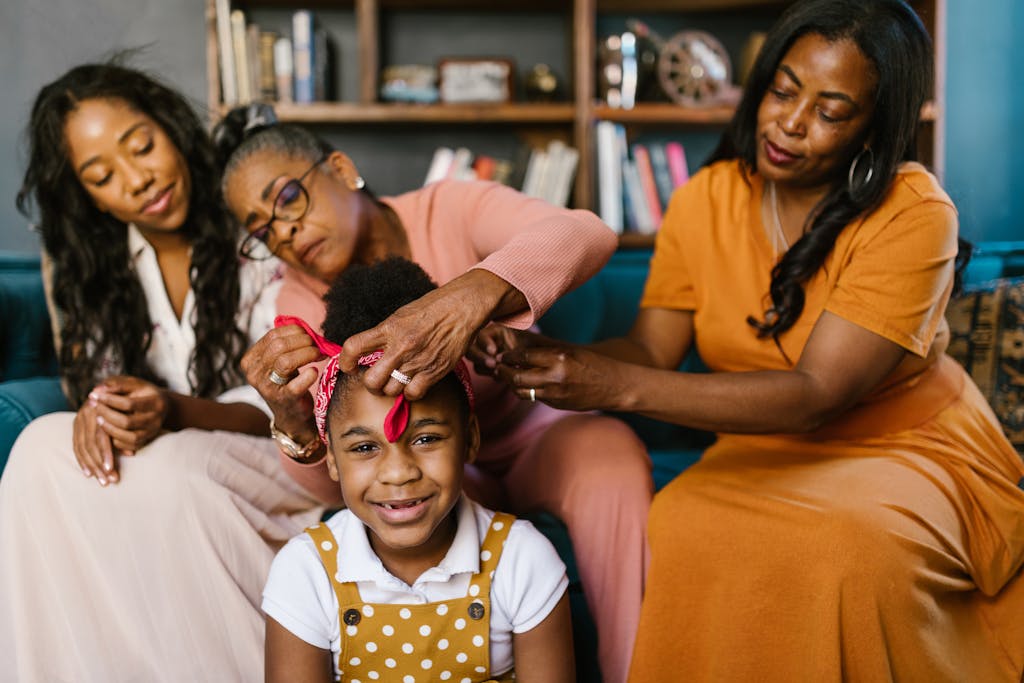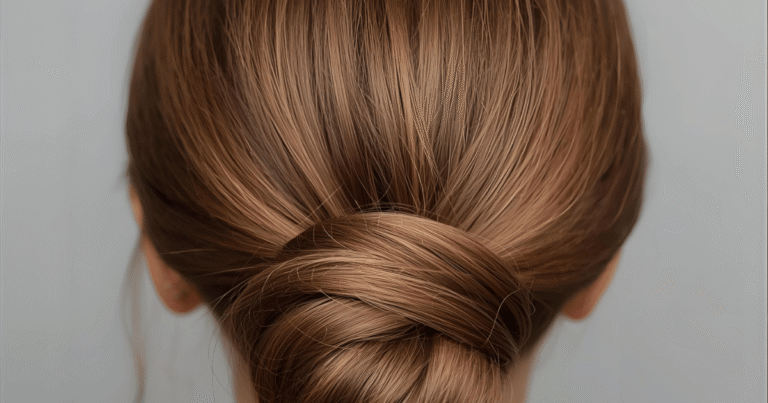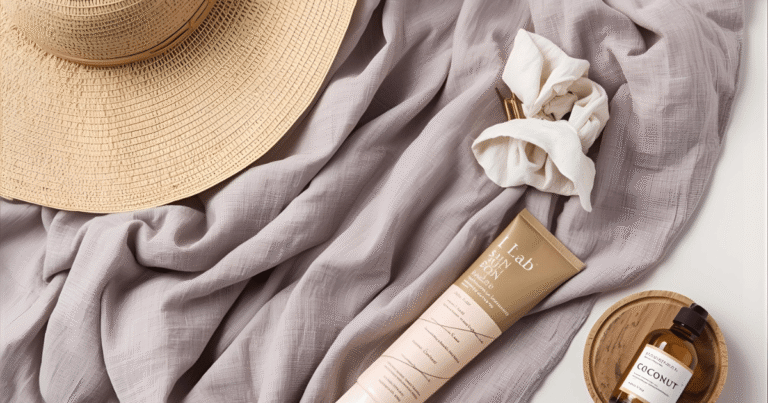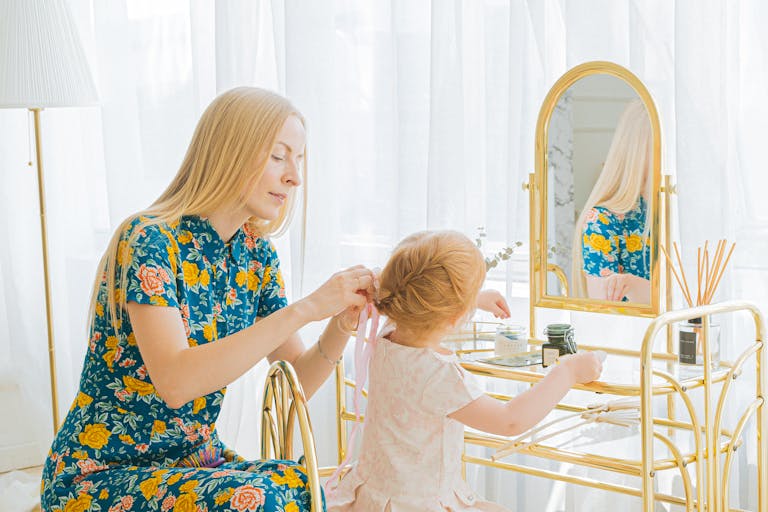My second daughter was born with a full head of hair that looked lovely in the hospital photos but proved to be wildly temperamental by age two.
Fine, wispy strands that tangled if you looked at them wrong. Static that made her look like she’d stuck her finger in an electrical socket. And tears. So many tears during brushing time that I started to dread the entire routine.
I tried everything the internet suggested. Detangling sprays that made her hair greasy. Brushes that promised to glide through tangles but just pulled harder. That one horrifying YouTube tutorial that recommended using fabric softener (I did not try that one, thankfully).
What finally helped wasn’t a magic product. It was understanding that her fine, straight hair had completely different needs than my eldest daughter’s thick, wavy hair. Once I stopped treating them the same and started approaching each child’s hair on its own terms, everything changed.
Hair care time transformed from a battle into something we could actually both survive. Sometimes we even enjoyed it.
If you’re struggling with your daughter’s hair, chances are good you’re not approaching it wrong. You’re just approaching it in a way that doesn’t match her specific hair type. Let’s fix that.

Why Hair Type Matters (And How to Figure Out What You’re Working With)
All hair is not created equal. This seems obvious when you say it out loud, but it’s easy to forget when you’re standing in the hair care aisle staring at products that claim to work for “all hair types.”
They don’t. Hair that’s fine and straight needs completely different care than hair that’s thick and curly. Using the wrong products or techniques doesn’t just fail to help; it actively makes things worse.
Understanding the Three Variables
When we talk about hair type, we’re actually talking about three separate characteristics:
Texture refers to how each individual strand feels. Is it fine (thin diameter), medium, or coarse (thick diameter)?
Density refers to how much hair there is total. Lots of strands per square inch means high density. Fewer strands means low density.
Pattern refers to whether hair grows straight, wavy, curly, or coily.
A child can have fine-textured hair (thin strands) that’s also dense (lots of those thin strands). Or thick-textured hair that’s sparse. All these combinations need different approaches.
The Pull Test
Not sure what you’re working with? Try the pull test: Take a single strand of your daughter’s hair and hold it between your fingers. Can you barely feel it? That’s fine. Feel it clearly but it’s not stiff? That’s medium. Feels like sewing thread? That’s coarse.
For density, look at her scalp when you part her hair. Can you easily see the scalp? That’s lower density. Scalp hard to see? Higher density.
Pattern is obvious just by looking: straight falls straight, wavy makes an S shape, curly forms spirals, coily forms tight coils or zig-zags.
Now let’s talk about what each type actually needs.

Fine Hair: The Delicate Dance
Fine hair is beautiful but challenging. Those thin strands are more fragile than thicker ones, which means they break more easily, tangle more readily, and show damage faster.
What Fine Hair Needs
Gentle everything. Fine hair can’t handle aggressive brushing, tight elastics, or rough towel-drying. The strands literally can’t take the stress without breaking.
Lightweight products. Heavy conditioners, thick oils, and rich styling products weigh fine hair down, making it look flat and greasy. You need formulas that moisturize without adding weight.
Volume at the roots. Fine hair tends to lie flat against the scalp, especially if there’s also high density. Volumizing products applied only at the roots help create lift.
Frequent washing. Fine hair shows oil more quickly than thicker hair. Washing every day or every other day is often necessary, which is fine as long as you’re using gentle formulas.
The Fine Hair Routine
Washing: Use a gentle, volumizing shampoo. Focus on the scalp, letting suds run down the length rather than scrubbing the ends. Rinse thoroughly; leftover product weighs fine hair down more than any other type.
Conditioning: Apply lightweight conditioner only from mid-length to ends. Never put conditioner on the roots of fine hair. Leave on for just a minute or two, then rinse completely.
Drying: Squeeze (never rub) excess water out gently. Use a microfiber towel or soft t-shirt rather than terrycloth, which creates friction damage. Air-dry when possible; if blow-drying, use low heat.
Brushing: Use a soft-bristle brush or a detangling brush specifically designed for fine hair. Start at the ends and work up in small sections. Never brush when fully wet; that’s when fine hair is most vulnerable.
Styling: Fabric-covered elastics only; never bare rubber bands. Keep ponytails and braids loose. If using clips, make sure they have smooth edges and don’t grip too tightly.
Products for Fine Hair
Look for: volumizing shampoos, lightweight conditioners, leave-in sprays (not creams), and silicone-free styling products.
Avoid: heavy oils, thick masks, anything labeled “intense moisturizing,” and products with silicones that build up.
Thick Hair: Taming the Mane
Thick hair is the opposite problem: instead of too delicate, it’s almost too resilient. Those thicker strands can handle more, but they also need more moisture and more effort to keep manageable.
What Thick Hair Needs
Serious moisture. Thick strands have more surface area to cover with natural oils, so they tend to be drier, especially at the ends. They can handle rich, heavy products that would overwhelm fine hair.
Strong accessories. Standard drugstore elastics snap under the weight of thick hair. You need sturdy, high-quality holders designed for thick hair.
Patience with drying. Thick hair takes forever to dry. Plan accordingly, because rushing with high heat causes damage.
Sectioning. When washing, conditioning, or detangling, work in sections. Trying to handle all that hair at once doesn’t work.
The Thick Hair Routine
Washing: Use a moisturizing shampoo. Section hair into four parts (like making pigtails, then splitting each pigtail in half) and wash each section to ensure you’re reaching the scalp everywhere.
Conditioning: Use a rich, moisturizing conditioner from mid-length to ends. Leave on for at least three minutes (longer for very thick hair). This is when you detangle: while conditioner is in, use a wide-tooth comb to work through knots, starting at the ends and working up.
Drying: Squeeze water out section by section. Wrap in a microfiber towel and let it absorb for 10-15 minutes. Air-dry as much as possible; when blow-drying, work in sections on medium heat.
Brushing: Use a paddle brush or detangling brush. Section the hair and brush one section at a time. Trying to brush all thick hair at once creates frustration for everyone involved.
Styling: Invest in strong elastics and secure clips. For updos, use more bobby pins than you think you need. Thick hair’s weight works against you, so over-secure rather than under-secure.
Products for Thick Hair
Look for: moisturizing shampoos and conditioners, leave-in conditioners, natural oils (coconut, argan), and deep conditioning masks for weekly use.
Avoid: clarifying shampoos (too drying for regular use), lightweight products that won’t provide enough moisture, and cheap accessories that break under thick hair’s weight.
Curly Hair: Embracing the Spiral
Curly hair is its own category because the curl pattern changes everything about how you need to care for it. The number one rule: never fight the curl. Work with it.
What Curly Hair Needs
Moisture, moisture, moisture. The curl pattern means natural oils from the scalp can’t travel down the hair shaft easily. Curly hair is almost always drier than straight hair and needs extra hydration.
Gentle handling. Aggressive brushing breaks up curl clumps and creates frizz. Most curly hair should never be brushed when dry.
Product to define curls. Without products, curly hair often becomes undefined and frizzy. Curl-defining creams or gels help curls form properly.
Less frequent washing. Curly hair shouldn’t be washed daily. Two to three times per week is typically plenty, with co-washing (conditioner only) in between if needed.
The Curly Hair Routine
Washing: Use a sulfate-free shampoo (sulfates strip too much oil from already-dry curly hair). Focus on the scalp. Wash only 2-3 times per week.
Conditioning: Use a rich conditioner. This is where you detangle: with conditioner in and hair soaking wet, use fingers or a wide-tooth comb to gently separate curls. Never force through knots; work patiently.
Drying: After rinsing conditioner, squeeze (never rub) out excess water. Apply curl-defining cream or gel to soaking-wet hair, scrunching upward to encourage curl formation. Either air-dry or use a diffuser on low heat.
“Brushing”: Don’t. Seriously. Curly hair should be detangled only when wet with conditioner in it. Brushing dry curly hair creates a frizz cloud. If you must brush dry curly hair for some reason, use a soft-bristle brush and brush gently, but know that you’ll need to re-wet and re-style to get the curls back.
Styling: Use accessories that don’t require hair to be perfectly smooth. Embrace the curl. Satin-lined headbands and fabric bows work beautifully with curls. Avoid metal clips and tight elastics that create kinks in the curl pattern.
Products for Curly Hair
Look for: sulfate-free shampoos, rich conditioners, leave-in conditioners, curl-defining creams or gels, and natural oils.
Avoid: anything with sulfates, products with drying alcohols, and especially, do not use brushes on dry curly hair.
Wavy Hair: The In-Between
Wavy hair sits between straight and curly, which means it can go either direction depending on how you treat it. Handle it like straight hair and you’ll lose the wave. Handle it like curly hair and it might get weighed down. The sweet spot is somewhere in the middle.
What Wavy Hair Needs
Balance. Enough moisture to enhance the wave without so much that it gets flat and greasy. Light enough products that don’t weigh it down, substantial enough to control frizz.
Enhancement, not fighting. You can emphasize the waves or smooth them out, but trying to make wavy hair be something it’s not creates frustration.
Flexibility. Some days air-dry and scrunch for beachy waves. Other days blow-dry smooth. Wavy hair is the most adaptable type.
The Wavy Hair Routine
Washing: Use a gentle, balanced shampoo. Frequency depends on the individual; experiment to find what works. Usually every 2-3 days is right.
Conditioning: Medium-weight conditioner from mid-length to ends. Detangle while conditioner is in if waves are prone to tangling.
Drying: Squeeze out excess water. For enhanced waves, scrunch in a light curl cream and air-dry. For smoother look, blow-dry with a brush. Wavy hair offers options.
Brushing: Can be brushed wet or dry, but wet is gentler. Use a wide-tooth comb for wet hair, a soft-bristle brush for dry hair.
Styling: All accessory types work well with wavy hair. Lucky you.
Products for Wavy Hair
Look for: balanced shampoos and conditioners (not too lightweight, not too heavy), lightweight curl creams or mousses, and optional texturizing sprays for enhanced waves.
Avoid: very heavy products (they’ll weigh waves down) and very light products (won’t control frizz enough).
Natural Black Hair: Special Considerations
Natural Black hair has unique characteristics that require specific care. The tight curl or coil pattern makes it the driest hair type because oils can’t travel down the tightly curved shaft. It’s also more fragile than it appears and prone to breakage if handled improperly.
What Natural Black Hair Needs
Maximum moisture. This cannot be overstated. Natural Black hair craves and requires intensive, consistent moisture.
Protective styling. Styles that keep ends tucked away and minimize manipulation help prevent breakage. Braids, twists, and protective updos serve real purposes beyond looking lovely.
Gentle handling. Despite seeming resilient, natural Black hair breaks easily. Gentle detangling, satin/silk protection at night, and minimal heat are essential.
The right products. Products formulated specifically for natural Black hair understand its needs. General “multicultural” products often don’t provide enough moisture.
The Natural Black Hair Routine
Washing: Sulfate-free shampoo, or better yet, co-washing (washing with conditioner only) which is gentler. Wash 1-2 times per week; more frequent washing strips too much oil.
Conditioning: Deep condition weekly with a rich mask. Leave on for 30 minutes minimum. For daily moisture, use leave-in conditioners and hair creams.
Drying: Air-dry when possible. If using heat, use low temperatures with heat protectant.
Detangling: Only detangle when hair is wet and coated with conditioner. Use fingers first, then a wide-tooth comb. Work in sections from ends to roots. Be patient; rushing causes breakage.
Styling: Protective styles that keep hair from tangling. On wash days, style while wet with plenty of product. Sleep in a satin bonnet or on a satin pillowcase every single night without exception.
Products for Natural Black Hair
Look for: sulfate-free shampoos, rich conditioners, leave-in conditioners, natural butters (shea, cocoa), natural oils (coconut, olive, jojoba), and edge control for styling.
Avoid: sulfates, drying alcohols, heat styling without protection, and cotton pillowcases.

Boys’ Hair Care: Keep It Simple
Boys’ hair care often needs to be streamlined. Most boys (and their parents) prefer quick, no-fuss routines.
What Works for Boys
Simple products. Gentle shampoo, maybe conditioner if hair is on the longer side. That’s often sufficient.
Quick routine. Wash, rinse, done. If hair is longer, add brushing. Keep it fast.
Regular cuts. Shorter styles require more frequent cuts but less daily maintenance. Find a barber or stylist who’s good with kids.
Let him participate. Even young boys can learn to wash their own hair and brush it. Building these habits early means one less thing for you to manage.
The Boys’ Hair Routine
Washing: Gentle shampoo, focusing on scalp. For longer hair, add a quick conditioner. For shorter styles, shampoo is often enough.
Drying: Towel dry and move on. Most boys’ styles air-dry just fine.
Styling: For longer hair, a quick brush. For shorter hair with a specific style, a light pomade or gel does the job.
Cuts: Every 4-6 weeks for short styles, less frequently for longer hair.

Common Hair Issues and Solutions
Let’s troubleshoot the problems that plague most parents.
Tangles
Prevention: Brush before bed. Braid long hair for sleeping. Use silk pillowcases.
Treatment: Detangling spray applied generously. Wide-tooth comb. Start at the very bottom and work up in tiny sections. Never yank.
Frizz
Causes: Dryness, friction, humidity, over-brushing, damage from heat or chemicals.
Solutions: More moisture (conditioner, leave-in products, oils). Silk pillowcases. Less brushing of dry hair. Embrace natural texture rather than fighting it.
Greasy Roots
Causes: Over-conditioning the scalp, not rinsing thoroughly, washing too infrequently (or sometimes too frequently, which triggers oil overproduction), using heavy products on fine hair.
Solutions: Keep conditioner away from roots. Rinse thoroughly. Experiment with washing frequency. Switch to lighter products. Use dry shampoo between washes.
Dry Ends
Causes: Not conditioning enough, over-washing, heat damage, chemical damage, old hair that needs trimming.
Solutions: Focus conditioner on ends. Deep condition weekly. Minimize heat. Get regular trims. Protective styles at night.
Breakage
Causes: Rough handling, tight elastics, sleeping on cotton pillowcases, over-washing, heat damage, chemical processing.
Solutions: Gentler brushing, better accessories, silk pillowcases, appropriate products for hair type, minimal heat, no chemicals on children’s hair.

The Bigger Picture: Hair Care as Connection
Here’s what nobody tells you when you’re crying over another failed attempt at detangling: hair care doesn’t have to be a battle. It can actually be connection time.
Once I understood my daughters’ different hair types and stopped fighting against what their hair naturally wanted to do, everything shifted. Hair care time became something we could both tolerate, and eventually, something we sometimes enjoyed.
We talk while I brush. We choose accessories together. We laugh about the cowlick that refuses to lay flat. These are the small moments that accumulate into relationship.
Your daughter is learning during hair care time, even if you’re not explicitly teaching. She’s learning whether her body is a burden or a blessing. She’s learning whether caring for herself is a chore or an act of love. She’s learning whether her natural hair is something to fight or something to celebrate.
These lessons matter.
“She is clothed with strength and dignity; she can laugh at the days to come.” (Proverbs 31:25)
May the way we care for our daughters’ hair be part of clothing them with that strength and dignity.
What’s your biggest hair care challenge with your daughter? Share in the comments—let’s help each other!
Continue Reading:
- DIY Dry Shampoo for Every Hair Color
- Thick Hair Care: Complete Guide
- Natural Frizzy Hair Tips
Want more practical help for the daily work of motherhood? Join our community for weekly encouragement, tutorials, and tips that actually work. Plus, get our free “Hair Care Routine by Hair Type” printable when you subscribe!







I love that you used the phrase “hair stewardship”. Thank you for the great tips! I will be keeping these ideas in mind when helping my daughter with her hair.